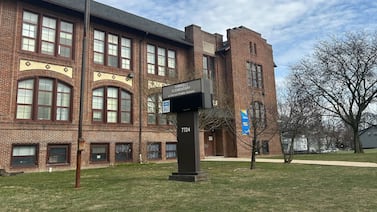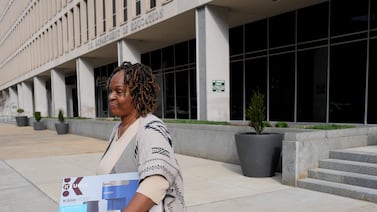Sign up for Chalkbeat Colorado’s free daily newsletter to get the latest reporting from us, plus curated news from other Colorado outlets, delivered to your inbox.
All Colorado school districts that have enrolled any migrant students since the Oct. 1 school funding cutoff date would get extra money — between $15,000 and $750,000 per district — under a draft bill approved unanimously on Friday by the powerful Joint Budget Committee.
But districts where the new arrivals have caused a net increase in students — meaning the district has more students now than on Oct. 1 — would get the most extra money. Those districts could get as much as an additional $4,500 for every newly arrived student.
The bill allocates $24 million to be distributed by May 31 to districts that have enrolled what it calls “new arrival students,” or students who moved to the United States less than a year ago, are not proficient in English, and are attending a U.S. school for the first time.
The city of Denver alone has served more than 39,000 new arrivals from Venezuela and other South American countries since it began keeping track more than a year ago, including families with children who have enrolled in public schools.
The details of how the $24 million would be doled out are somewhat complicated. First, there is a tiered system of lump sum payments to school districts based on the number of new arrival students they’ve enrolled since the October count. Districts would get:
- $15,000 if they’ve enrolled between one and five new arrival students
- $30,000 if they’ve enrolled between six and 10 new arrival students
- $75,000 if they’ve enrolled between 11 and 30 new arrival students
- $125,000 if they’ve enrolled between 31 and 50 new arrival students
- $200,000 if they’ve enrolled between 51 and 100 new arrival students
- $400,000 if they’ve enrolled between 101 and 200 new arrival students
- $550,000 if they’ve enrolled between 201 and 500 new arrival students
- $750,000 if they’ve enrolled 500 or more new arrival students
On top of that, districts with a net increase in enrollment would get $4,500 per student. Here’s where it gets complicated: Districts with a net increase would either get $4,500 for each migrant student they’ve enrolled or $4,500 per student based on the net increase, whichever is lesser.
If the $24 million isn’t enough to cover the costs, the bill says state officials can reduce the $4,500 per student to a lower dollar amount. If calculations show there will be leftover money, state officials could increase the $4,500 to a higher dollar amount.
State Rep. Emily Sirota, a Denver Democrat who sits on the budget committee, said in a text message that she’s happy that the bill could provide relief for districts statewide that are dealing with a “very out of the ordinary influx of new to country students arriving.”
Lawmakers have been working on the bill for over a month, debating various ways to dole out the $24 million. Sirota said the tiered funding proposal acknowledges districts incur fixed costs to educate any and all newly arrived students.
Friday’s vote by the budget committee finalized the language of the bill, but it has yet to be filed for consideration by the full Colorado General Assembly.
“I know my colleagues, our school districts, and our educators are going to be very excited to shepherd this bill across the finish line in the coming weeks,” Sirota said.
The funding is less than what school districts get for each student enrolled on Oct. 1: $10,614 on average. However, budget committee members wanted to earmark the $24 million to provide some relief for districts struggling with the extraordinary influx — money the districts would never get otherwise. (Students who stay enrolled next year will be factored into the school funding formula, and school districts will get money for those students.)
“This sudden influx has strained existing school infrastructure and staffing, led to overcrowded classrooms, stretched resources, and increased complexity to the student learning environment,” the bill says.
The bill also acknowledges that newly arrived students may need extra services, including English language development classes, mental health support, and more. Some may have been out of school for long stretches of time and need help catching up academically.
“New arrival students face unique challenges, including language barriers, cultural adjustments, and various academic backgrounds,” the bill says. “These unique challenges require specialized resources and support services.”
How much funding districts might get under the bill
Denver Public Schools and Aurora Public Schools have enrolled the most migrant students since the October count, according to data obtained through open records requests.
Denver has enrolled an additional 2,340 newcomer students, and Aurora has enrolled an additional 1,366 migrant students. Denver’s numbers were as of March 4, while Aurora’s were as of Feb. 29. The bill uses Feb. 29 as the date to calculate the difference between October count enrollment and how many students districts are serving now.
Accounting for students who left the districts between the October count and those dates, Denver had a net increase of 1,025 students, while Aurora had a net increase of 727 students.
Under the legislation, Denver Public Schools would get a lump sum of $750,000 for the 2,340 newcomers it has enrolled. The district would also get $4.6 million for the 1,025 net increase based on the $4,500 per student formula.
In Aurora’s case, the district would also get $750,000. And the district would get about $3.3 million for its total increase of students since the October count.
Most other districts that have enrolled more than 100 migrant students since the October count had either a much smaller net increase or a net decrease.
For instance, as of Feb. 29, the suburban Cherry Creek School District had enrolled an additional 532 newly arrived students since the October count. But the district has had a net decrease of 41 kindergarten through 12th grade students since Oct. 1.
Greeley-Evans School District 6 had enrolled 488 more migrant students, but only had a net increase of eight K-12 students. Adams 12 Five Star Schools had enrolled 389 additional students, but its school population only grew by 42 students.
And Jeffco Public Schools and Mapleton Public Schools had net decreases, despite enrolling 382 and 140 more new arrivals, respectively.
The student influx creates financial challenges for schools across the state, Brett Johnson, chief financial officer for Aurora Public Schools, said in an interview before the bill text was approved.
“There’s a real and specific impact of these 1,200 kids who have enrolled in our schools in terms of hiring new staff, repurposing classrooms for those schools,” Johnson said. “And those are real costs that are being incurred in real time.”
The challenges remain even in districts that have net decreases in overall enrollment.
A Cherry Creek spokesperson said the district has hired six staff members since January to support the new arrivals. Three of those hires are in newcomer classes and three are cultural liaisons who provide interpretation and other support to families who do not speak English.
Correction: This story has been corrected to update the per pupil figure districts get from the state.
Melanie Asmar is the bureau chief for Chalkbeat Colorado. Contact Melanie at masmar@chalkbeat.org.
Jason Gonzales is a reporter covering higher education and the Colorado legislature. Chalkbeat Colorado partners with Open Campus on higher education coverage. Contact Jason at jgonzales@chalkbeat.org.
Yesenia Robles is a reporter for Chalkbeat Colorado covering K-12 school districts and multilingual education. Contact Yesenia at yrobles@chalkbeat.org.






